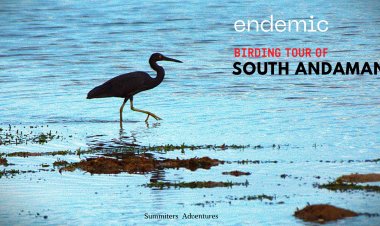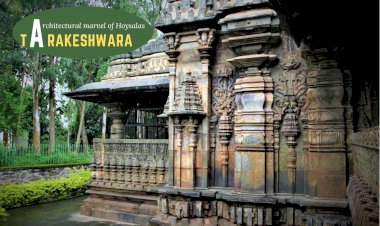back to back Kuduremukha, the other face of the horse
The Horse shaped Kuduremukha Peak has been a apple of eye by its pictursque landscape and rich ecological diversity. A most beloved and must preferred hiking weekend destination for many , being one of the highest peak in state of karnataka. Having seen it face to face , explored upteen times ,standing aloof on the peak, witnessing sun going down , the infatuation towards it made me to explore what lies beyond, a small curious attempt to explore what lies back to back of horse face, about the wild forests, the diverse life and more.Sure it will definitely interest you !

During a casual telephonic discussion, as my friend Sarayu incessantly began to describe the beauty of the place tucked away in the malenad region. The name MaLa itself sounded like an acronym and the stay namma manu MaNe literally was a tongue twister. It was enough to kindle interest in me to visit the place - a haven for lepidopterists and Herpetologists !
Though the unpredictable rains were creating havoc, get bitten by the obsession, we set off for a weekday-long exploration, to get drenched in the wild offbeat environs, get lost in the shadow of charming, back-to-back of the elusive peak on the fringes of Kuduremukha National Park.
Kuduremukha - is on the bucket list as a top dream destination that evokes a sense of adventure for a weekend adventure freaks, a pandora's box for those interested in natural history, naturalists , botanists, and photographers equally to quench their thirst. Though the eco-sensitive site has withstood tresspassing, natural calamities and surpassed human intervention is still thriving with natural beauty.Untouched and Unexpolored till today.
After a thrilling journey on the serpentine roads, in the wee hours as we crossed the forest check post We were bowled by the thick forest cover, undulating landscape of hills, and the rising thick fog . Still, we have no trace of our arrival or the destination...no single soul around nor sign boards nor google gurus to lead us to our destination. We had to our company, the never-ending deafening sound of gushing streams, cicadas, crickets, grasshoppers, and katydids - a nocturnal chorus indeed!
Finally the last house mane, arrived after a long haul and after sight of snugly perched overlooking a turbulent stream was our little paradise for a weeklong stay.
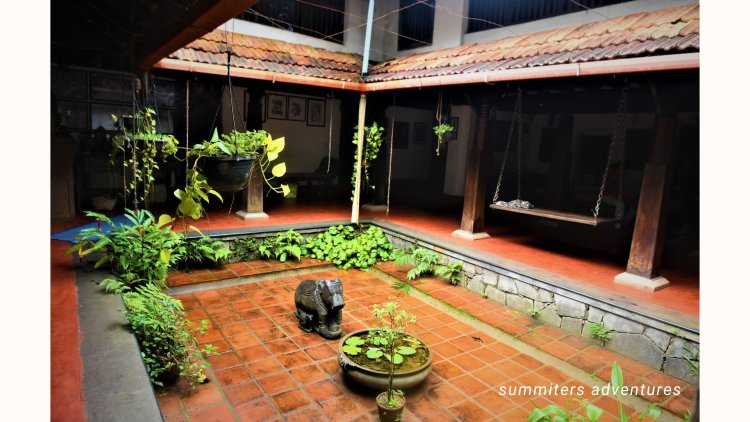
Though it was a bit tiring journey, It did not take much to stick to the schedule plan.
After sipping a cup of hot Kashaya - a local refreshing drink ( decoction ) made out of herbs. I took a stroll in the areca, cocoa plantation. I was flabbergasted to see, the whole plantation in sheer neglect and only a few countable habitations around - It looked eerie!
On the first part of the day, we spent exploring the heritage house thottimane with massive wooden pillars, wooden swing found in typical malenadu houses, said to be 200 years old - a museum, with a lot of artifacts and masks. idols and brass utensils, a mini library with reference materials, village indoor games,a interesting collection, and paraphernalia. Interacting with the caretaker and others

The interesting part is to watch the water sliding down the roof and falling down in the square tank while sitting in the courtyard, which can be experienced only in a typical malenadu house.
As the darkness fell we were fortunate to meet Mr. Prabhakar, a nature lover, and artist by profession. I learned that the whole collection was of a single man, to restore the cultural heritage, folklore forms of Tulu Nadu and the state
The yakshagana play and characters and performances, bhootharadhane rituals, and festivals of the coastal region. The pillars, doorways, and windows made out of bilkhambi wood - also referred to as temple wood with artistic doorways, with filigreework is were worth mentioning here.
In the thickets, a colorful plant caught my attention, glowing in the sunlight. It was a Shampoo ginger lily plant - zingiber zerumbet, the candle-like fleshy flowers were very attractive. I came to know that it is used as shampoo for the treatment of dry and damaged hair, repairing it. It also helps with dandruff and nourishes the scalp, thanks to its anti-inflammatory properties.
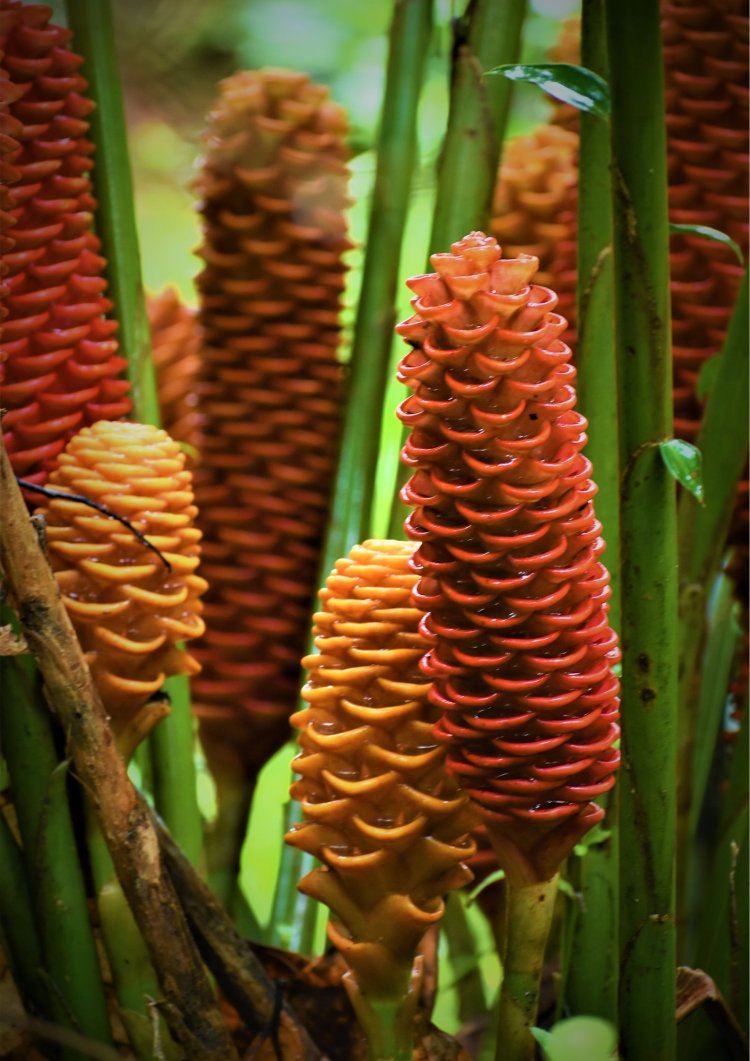
As it was breeding season of Blue Marmon Papilio polymnestor - The state butterfly of Maharastra and second large butterfly next to Southern Birdwing - which is the State buttefly of Karnataka.We could see them hovering around.It was tiring task to go behind them in bushes.
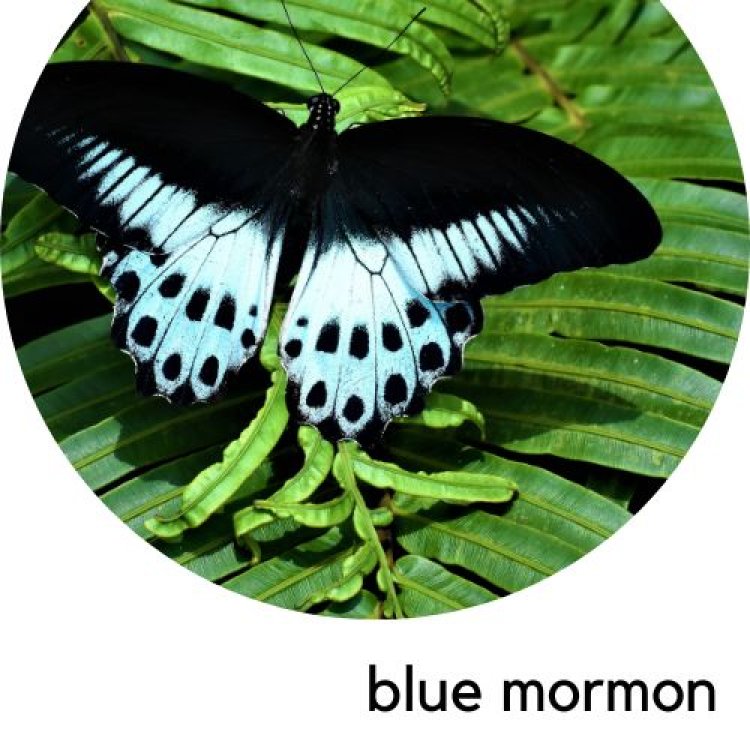
Peacock bird with its vibrant colors and plumage itself is not beautiful...
Indian Swallow tail Butterfly is no less. with its lovely iridescent green colour on the upperside of its wings and bright blue patch...Two long tails and a few red spots complete the attire of this magnificent butterfly.
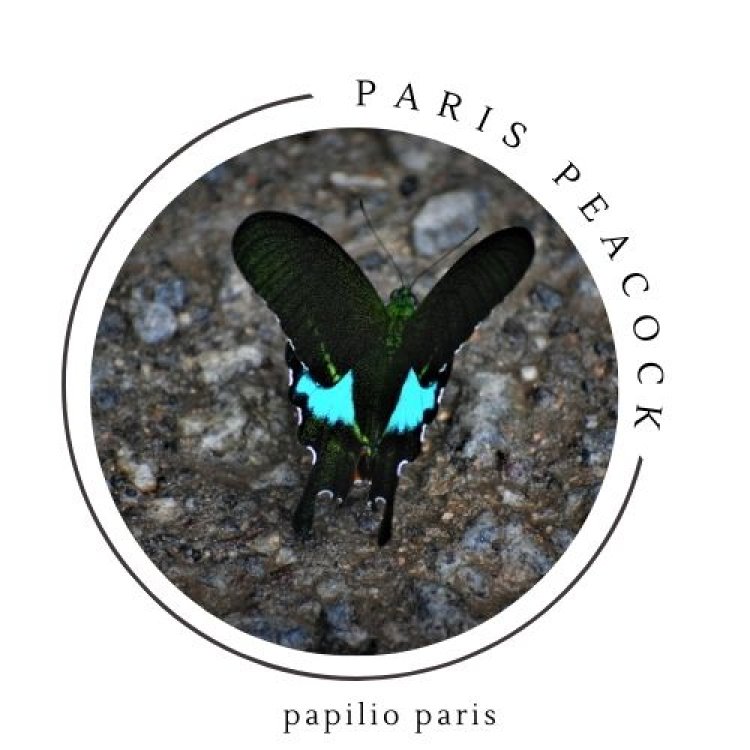
Papilio paris, commonly called Paris Peacock, is a highly restive, black and green Papilionid butterfly found in India
Few Facts
- Peacock butterflies display a remarkable ability to defend themselves, though they do not have any poisonous substance on them. The caterpillar, on the other hand, has a stinging organ which is used to scare away its enemy. The venom, however, is not strong enough to harm humans.
- Swallowtails are well known for mud puddling in large numbers. Mud puddling is a behaviour exhibited mainly by male butterflies. The butterflies sit on moist soil, animal dung or urine and suck up liquid nutrients using their proboscis (their tube-like mouth) from which they get minerals such as sodium which increase their chances of success during breeding.
Threats
Being beautiful is a disadvantage too. Due to their colourful wings swallowtail butterflies are very much sought after by insect collectors to make decorations and for display.
The Red Helen - Papilio Helenus, a large swallowtail butterfly, as they are diurnal, Indias third largest butterfly with its wingspan, we could spot busy hovering around pagoda flower - Clerodendrum paniculatum locally known as Chariot flower - Ratha Pushpa.I was surprised though its a black beauty and white from inside, why its called Red Helen?
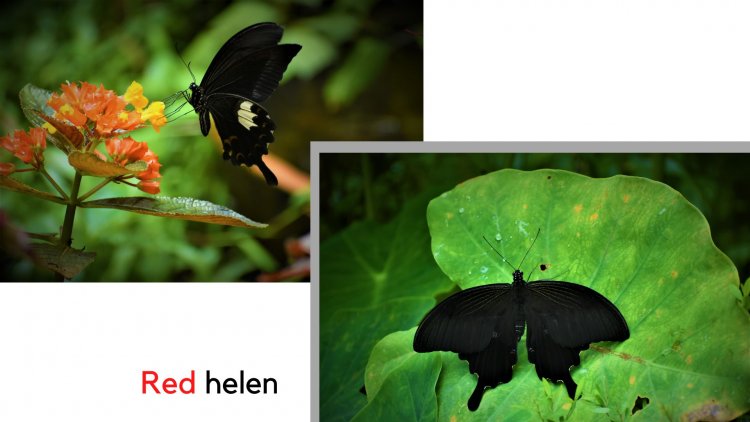
The habitat is ideal to spot butterflies, as it was sunny we could spot a few months and butterflies too, active during the daylight.
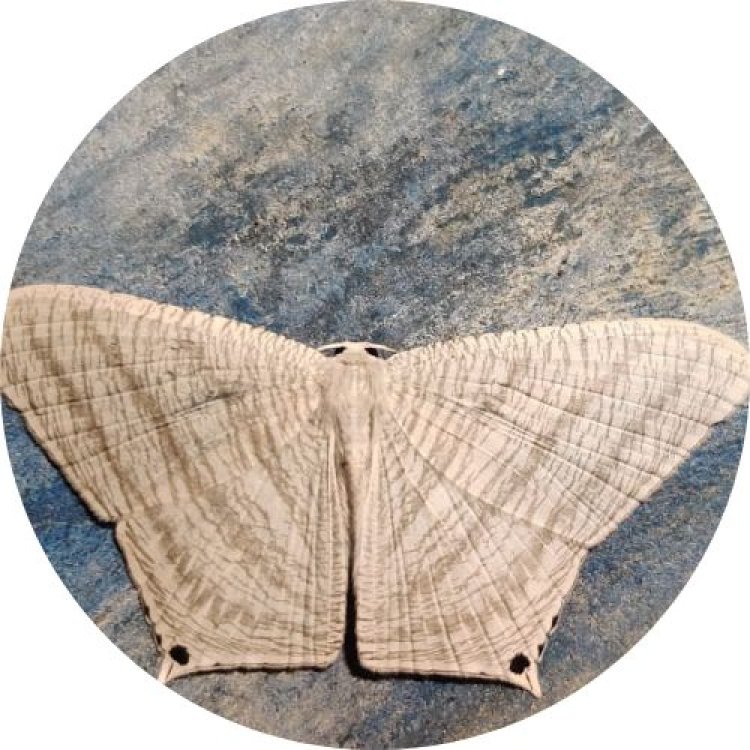
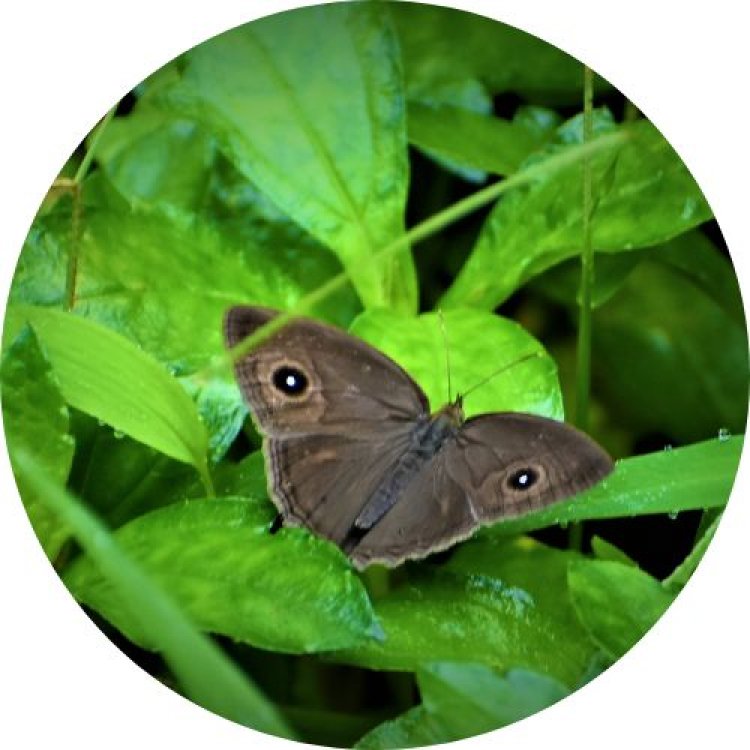
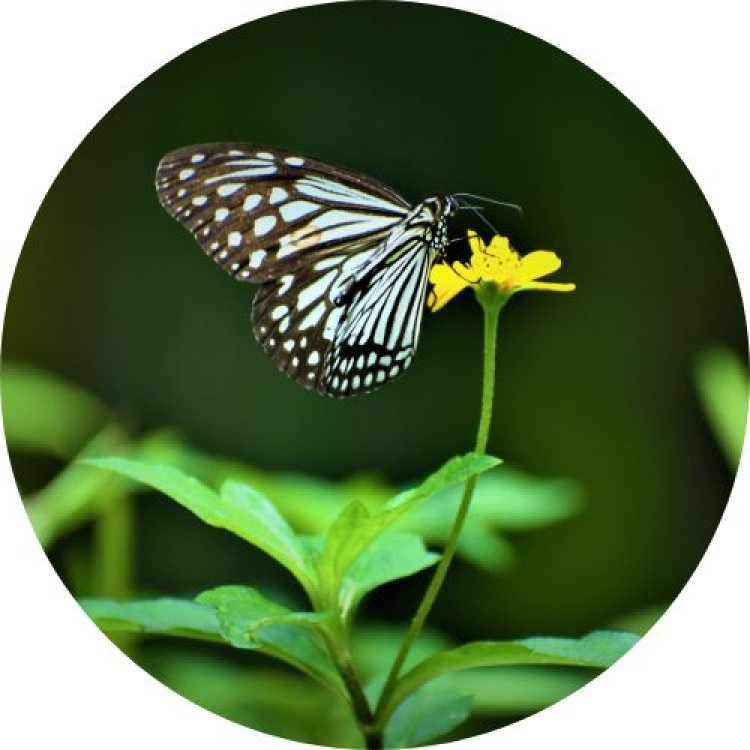
We could spot a giant Indian Tiger Centipede crawling around about 8 inches in length, with large antennas moving slowly on the stony bushes, the bright orange, and black bands/segments, orange legs make and one thinks this variation makes these centipedes appealing to people who like 'weird' things in nature.

We could spot a few dragonflies Wasps, and Beetles, they are powerful fliers and runners and fliers that can easily capture a variety of prey. When handled, tiger beetles can inflict a painful bite with their long mandibles. We could see the cicadas resting on the bark of trees and keeping us active with their live orchestra.
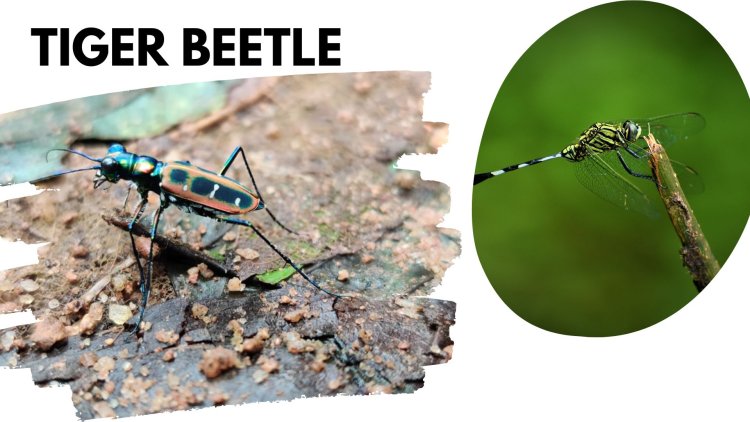
Cicadas
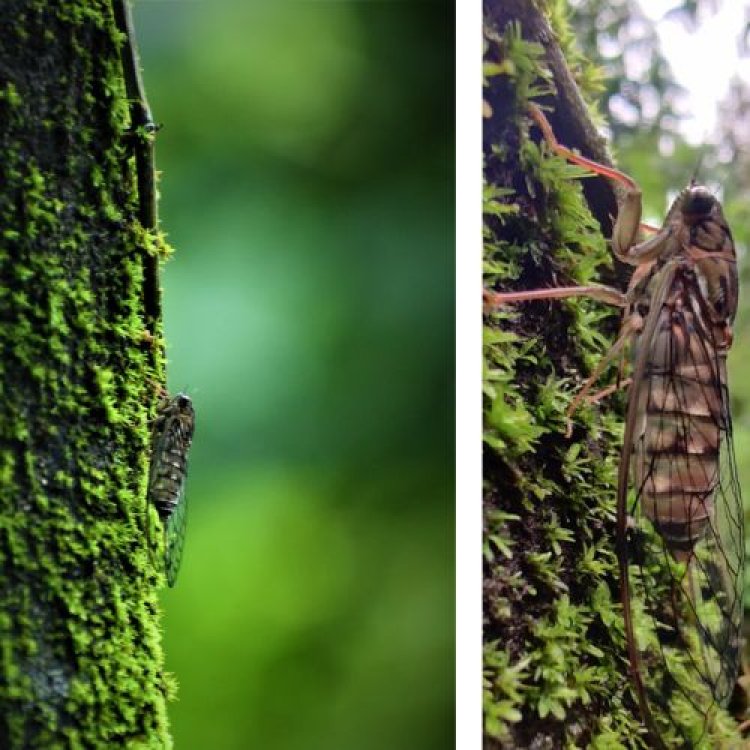
Afternoons were meant to rest after a typical Malenadu lunch. Discussions about the sightings and referring to books.A sudden downpour duirng one of the days made us plan a long night outing to get a glimpse of night life with nocturnal creatures.
The small, geckos often reffered to lizards mostly carnivorous were interesting to photograph, few resting on the tree tops, waiting for the hunt and few feasting a moth on rocky bed.
We moved closer to make images as close as possible.It's quite uncommon for a gecko to bite, but they can if they feel threatened or are being territorial. Since they are quite timid creatures, its more likely for them to run off rather than attack.
Roux's forest lizard
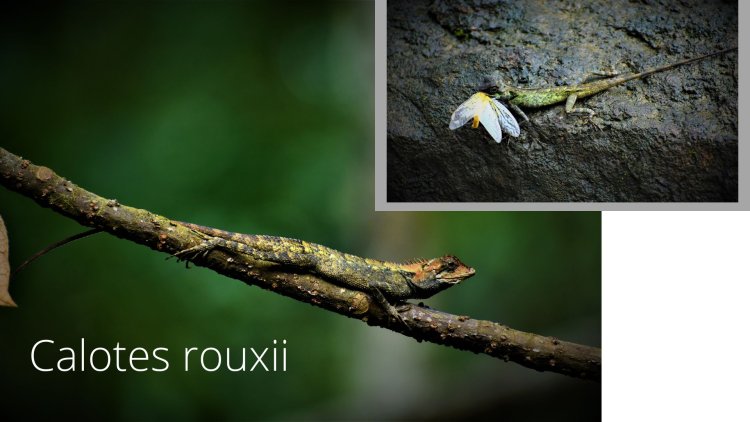
Monilesaurus rouxii, commonly known as Roux's forest lizard, Roux's forest calotes, or the forest bloodsucker, is a species of arboreal, diurnal, ...
The Areca plantation and adjoining trees are home to variety of lizards and can be only spotted using binocs or with sharp eyesight. The lizards are camouflaged and their skin color resembles bark of the tree.
In a recent study, researchers say Calotes – the genus to which garden lizards belong and are found in the Western Ghats – are actually related to three different clades, groups of organisms that share a common ancestor.
In all, they have found two new genera and two new species, both of lizards.
Of these three groups, two are endemic to the Ghats, and which the researchers have named new genera called Monilesaurus (‘lizards with a necklace’) and Microauris (‘lizards with small ears’). They identified two species not known earlier within the genus Monilesaurus and named them as Monolisaurus acanthocephalus (‘spiny headed’) and Monolisaurus montanus. The former is from the Meghamalai hills while the latter dwells in the wet, green high-elevation forests of Kundremukh to the Nilgiri hills of the Ghats.
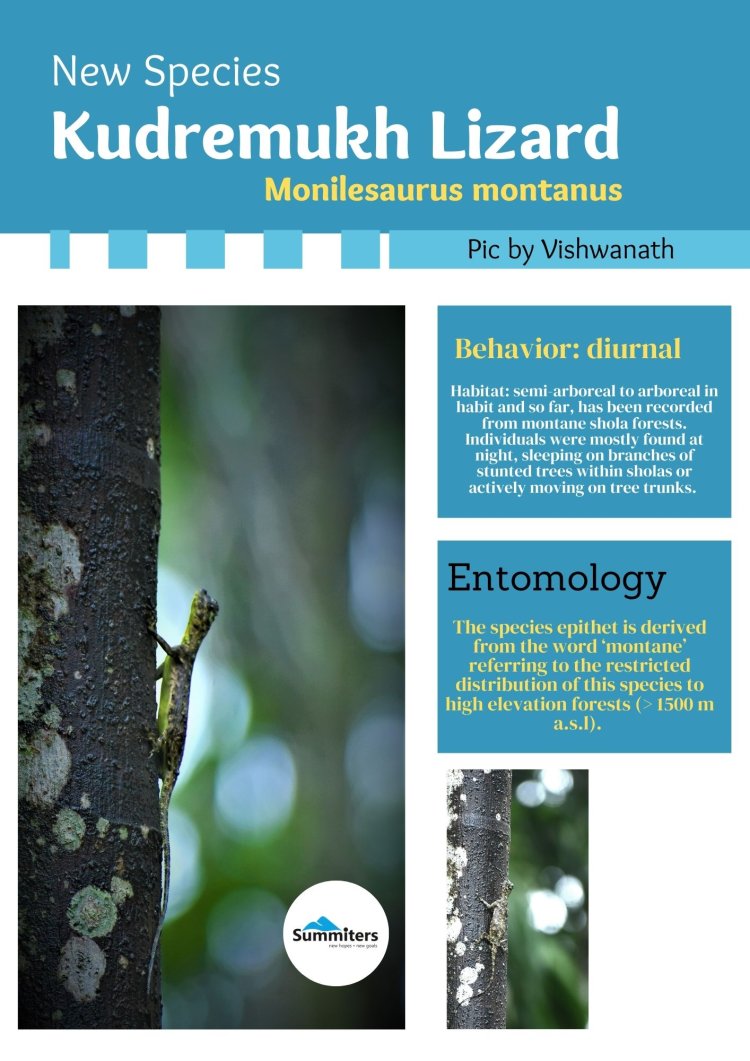
The Western Ghats seems to host such intellectuals of different persuasions, and continue to reveal the evolutionary wonders of species it is home to.
After a siesta, with a cup of coffee we use to compare the field observations with discussions with reference material.
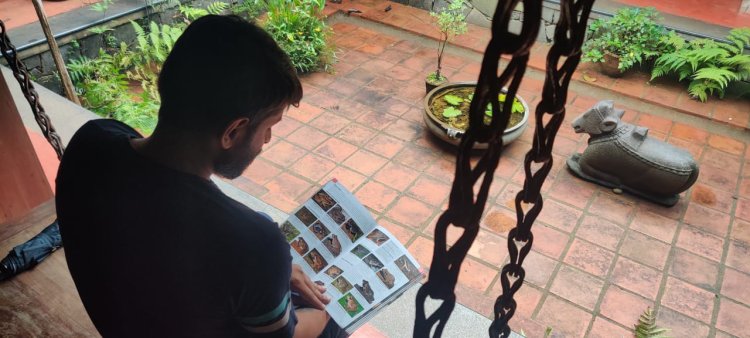
Every day as it gets dark and after dinner,armed with torch we escorted by Afran our fiield guide used to venture into bushes and streams to see the nocturnal creatures.I used to only think of beetles, crickets and cicadas when i used to hear the loud buzzing sound.
To my dismay, during calm night i could notice and listen to live orchestra of Grasshoppers,Kalidasa Lanata, Katydids and Mantis too.
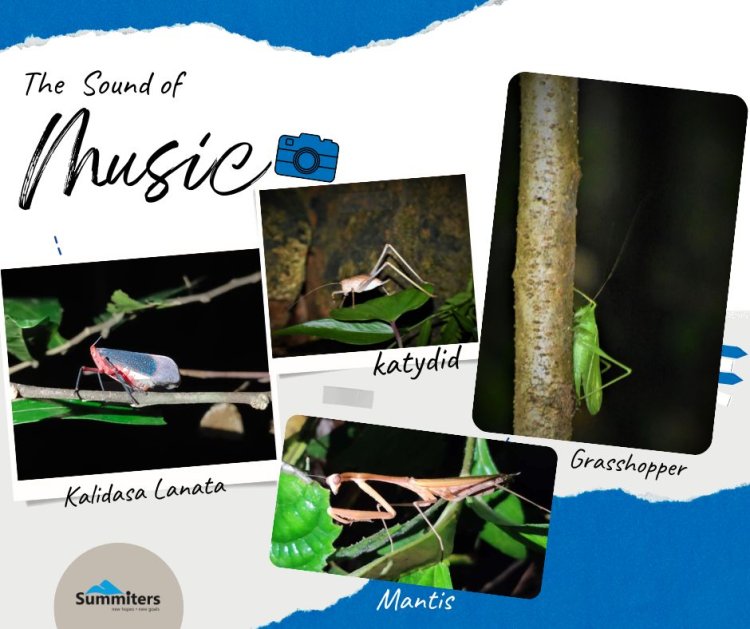
Both male and female katydids sing to attract mates, and use their long antennae to find each other.
Whereas Mantis do make a hissing sound when they are threatened.
Grasshoppers. Grasshoppers are another group of insects that use sound in their everyday life. One way they make sounds is by rubbing one of their hind legs, which has rows of pegs on the inside, against the stiff outer edge of their wing. These sounds are produced in order to find a mate and protect their territory.
Unmindful of drizzle and leech bites we were deep inside the thickets did not know the passage of time, we were busy in exploring the thickets and water bodies.
Afran imitated the calls of frogs and disappered into bushes, we soon followed him, holding our headlamps.We could spot Wayanad Bush Frog, inside the bushes of a tree. The tiny ones are difficult to spot,folowing the call direction and close observation is the only way to trace them.
Commonly known as the Wayanad bush frog, common bush frog, Jerdon's bush frog, plain-colored bush frog, Tinkling Frog, Malabar coast frog.The species came to limelight to the outer world by Mr.Jerdon in year 1853
Small-sized frog (length 28 mm in males and 33 mm in females). Pointed snout. Tympanum distinct. belly being granular.
A close observation reveals triangular white spot on snout. Upper two-third of tympanum dark black. Throat light greyish yellow with minute spots.
They are arboreal and spend most of time climbing or resting underneath of barks, holes of barks and leaves.
Kudremukh Bush frog
Also referred to as Knob handed bush frog...(is a species of frog in the family Rhacophoridae. It is endemic to the western ghats where it is found in Karnataka and Kerala states
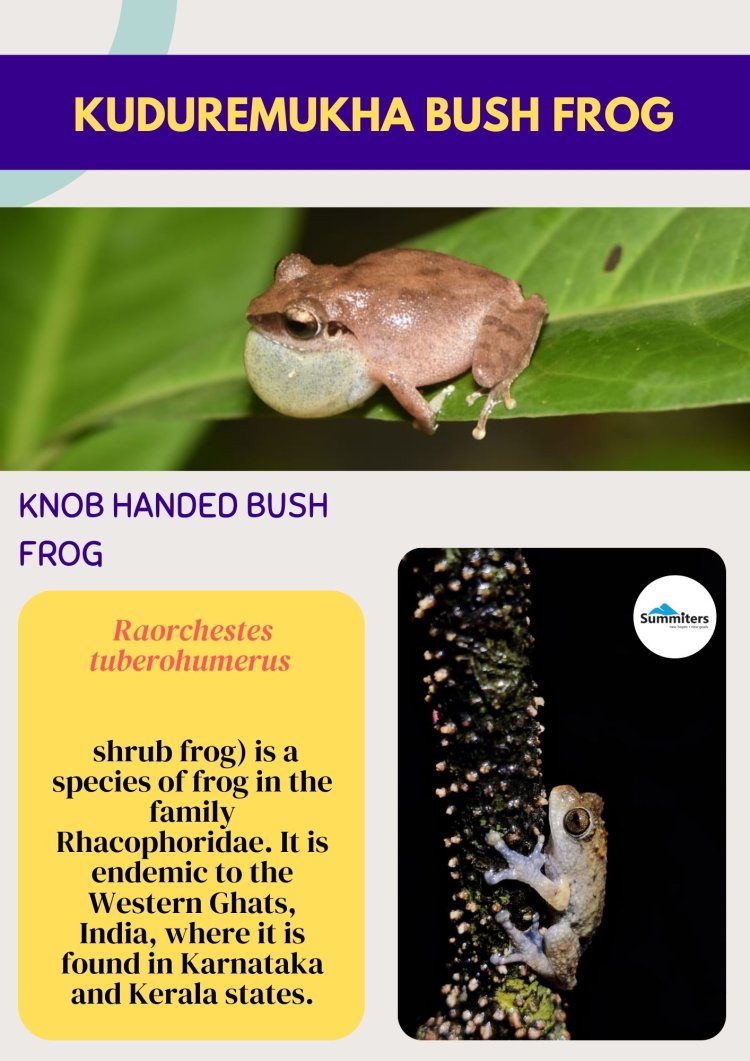
This small sized shrub frog (male snout-vent length 22–19 mm) is diagnosed by the following combination of characters: Snout sub elliptical in shape; iris golden brown; the humerus bone slightly projects on the ventral region near shoulders; light grey dorsum with spinular projections and prominent yellow patches with brown on the groin region
Normally sighted on shrubs in forests, plantations, home gardens and road side vegetation between 500 and 1500 m elevation. They are known to face down towards ground and vocalize on dead leaves on shrubs.
Its been declared Vulnerable category (IUCN Status ) because of its habit loss.
Kempholey Night Frog
Also referred to Kempholey Wrinkled frog
It is a species of amphibians Nyctibatrachus kempholeyensis.They are found in the indo-malayan realm.
This species was discovered by C. R. Narayan Rao and was thought to have been extinct after remaining unsighted for 74 years
They are aquatic , normally sighted in the wetlands and wet forests.They are Pinkish dorsum with white parallel lines
They can be identified as below, small-sized frog (length 24 mm in males and 27 mm in females). Y-shaped ridge on snout. Glandular fold on dorsum, giving a square appearance. Strong fold from eye to shoulder. Pupil horizontal. Finger and toe discs with dorso-terminal groove, cover rounded distally
They rely on saltation to move around.- (Bipedal jumping.) Behavior related to the upward thrust produced by the rapid, simultaneous extension of the hind legs with the intend to rise in the air.Arfan could spot a Kempoley frog with 20 eggs in of the leaf underneath.
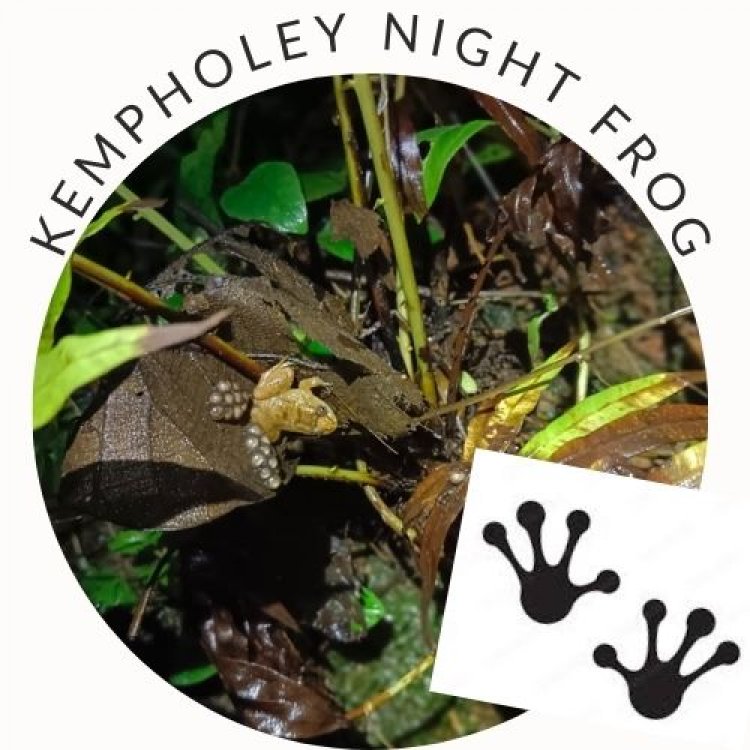
Malabar Tree Toad
Also known as Pedostibes tuberculosus) or warty Asian tree toad, is a species of toad found in forests along the Western Ghats of Karnataka
This species is known to live in tree habitats, but adults are found among leaf litter, climbing into trees at night. They are found in the forest of the Western Ghats at elevations of 250 m to over 1000 m, often beside streams or water bodies
It is a small species and is found in wet tree hollows or leaf bases containing water.
This is a slender frog with a moderate-sized head. The snout is pointed and the lores are vertical. The distance between the eyes is as wide as the upper eyelid width. The ear opening (tympanum) is well marked and is about a third of the diameter of the eye. The fingers are moderate, depressed, and webbed at the base. The first finger is half the length of the second. The toes are almost entirely webbed and the tips of both fingers and toes are dilated into broad.
The male has a subgular vocal sac.Females are larger than males. Adults of this toad grow to 3.6-3.85 cm in length.
The call is described as a "shirrrr shirr shirr shirr", with a dominant frequency of 3780 Hz, each call lasting 3 to 7 sec with three to 10 pulses
"The Malabar Tree Toad stays on trees for much of its life, only coming down during the breeding season.
Malabar Tree Toad is a species categorised as ‘Endangered’ on the IUCN LIST, owing to severely fragmented habitats.
We could spot Dancing frogs are also known as torrent frog, Kottigehara Bush Frog, Western Tree Frog and Malabar Gliding Frog

The sound of the creatures intensified and inbetween we were able of sight geckos getting reading for their dinner time.We wereable to see the way they hunt patiently.Though they noticed our presence they did not mind and get distracted !
We were able to identify it as Deccan Banded Gecko
Cyrtodactylus deccanensis, also commonly known as Günther's Indian gecko
Deccan Banded Gecko - banded ground gecko, is a species of gecko found in the northern Western Ghats of India. It has been found from northern Maharashtra, with a habitat range possibly extending to southern Gujarat.
Being a nocturnal species that lives in forests they are rarely encountered. The deccan ground gecko lives on forest floors and is insectivorous.
Our frog walk resumed, we were, looking for some Vipers as it was a frogs habitat, but no clue, only a juvenile Keel back, appeared and slithered under foliage.The night out with frog was truly interesting.
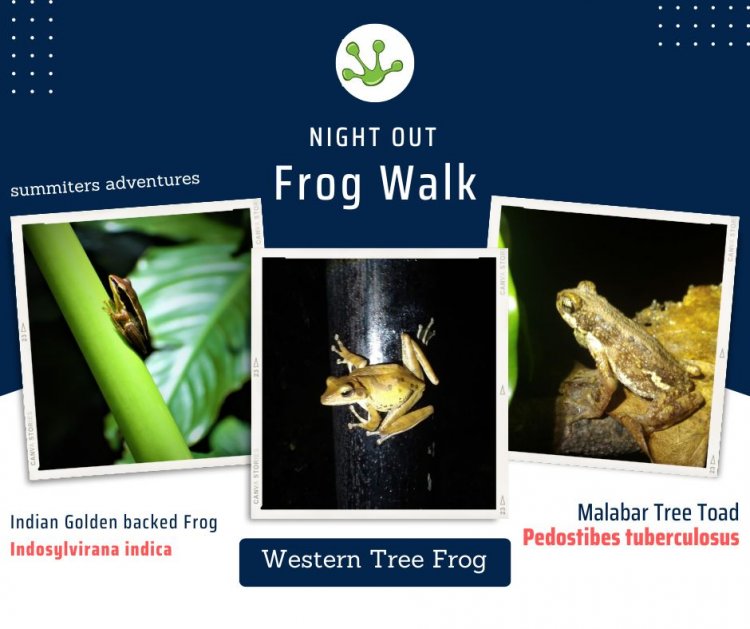
-----

Discovered in 1876 by scientist Albert Gunther, the Malabar Tree Toad (Pedostibes tuberculosus) is a species endemic to the Western Ghats.
Experts have suggested declaring Malabar Tree Toad as the state frog.
The reason is because of its sighting in the Western Ghats and its status as an endangered species IUCN listing.
Nights were meant for exploration everyday, we could notice Spider busy in weaving web, Parawixia dehaani
Parawixia dehaani, known in Australia as the abandoned-web orb-weaver, is a species of orb weaver spider from the family Araneidae
which is widely distributed in Australasia and eastern Asia..It is also known as garden spider.
The female Parawixia dehaani is a large, dark brown spider with variable patterns on the abdomen. The most noticeable field characteristic is the triangular abdomen having corners with sharp spikes.
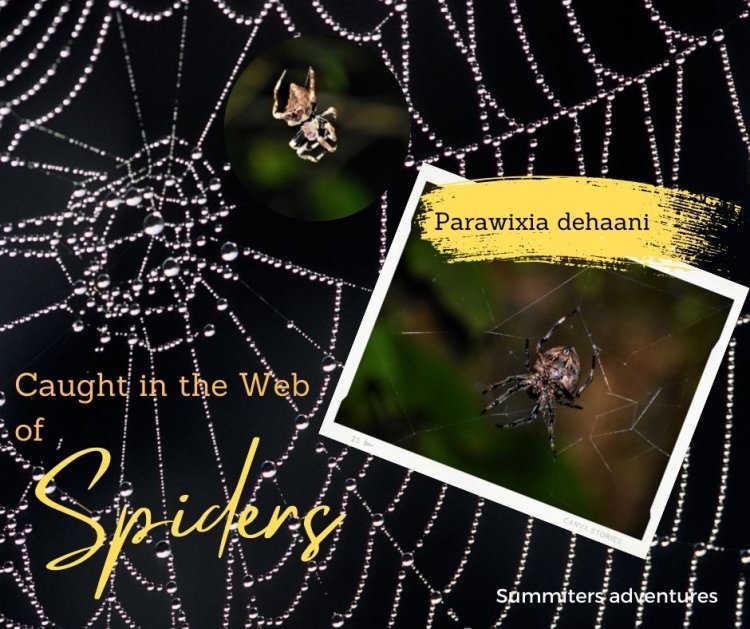
In the holes of one of the large tree we could a black Spider,seem to pose to us and guarding its nest.
Vinay observed it and noticed eggs laden on the green leaf and few small baby spiders Spiderlings , white in color glowing in torch light.
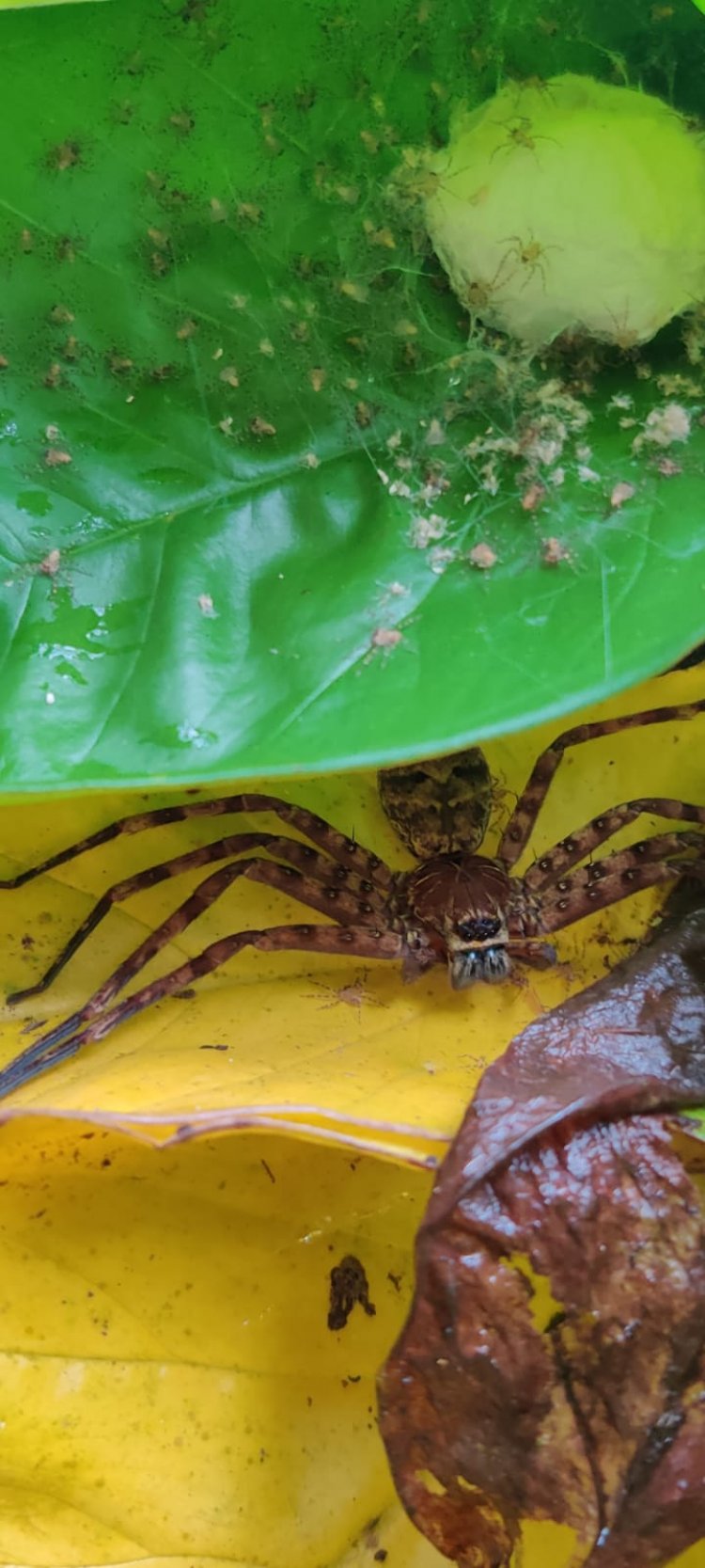
Aryan mentioned it as Huntsman Spider.
Huntsman spiders, members of the family Sparassidae (formerly Heteropodidae), are known by this name because of their speed and mode of hunting.
Huntsman Spiders are found living under loose bark on trees, in crevices on rock walls and in logs, under rocks and slabs of bark on the ground, and on foliage. Dozens of the social huntsman species,
We did go close to it and photographed its nest, although its bite is harmful, but not deadly A cold pack may relieve local pain. Seek medical attention if symptoms persist.
On one of the days by the time we reached back to our little paradise it as late night.
The rains which had taken a break resumed again morning , we visted the waterfall cloeby known as Shastri Gundi which cascades 40 feet in height and after breakfast we bid good bye to host with a heavy heart.
I was literally so obsessed to place.It was memorable trip and experience of lifetime !
The otherside of Kuduremukh has a different identity and regarded as hotspot for those who look for diverse life.Though the peak is not visible Thick evergreen forest with patched sholas,of Kurch Kallu gudda and nearby makes it offbeat destination.
This place is not for casual trekkers nor leisure homestay weekend freaks but only for those with a purpose.









